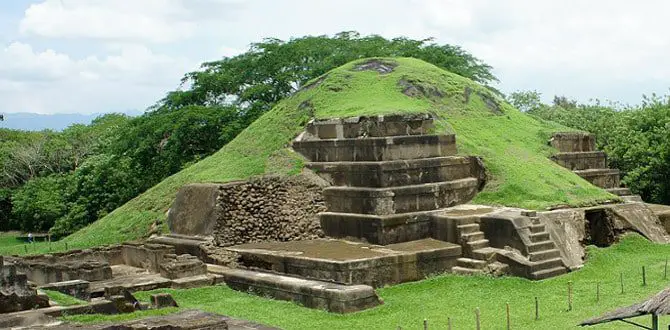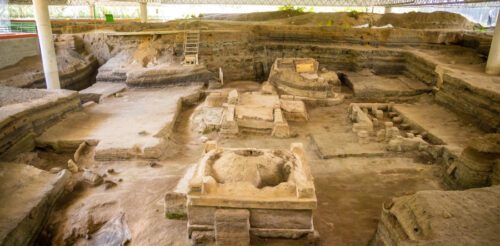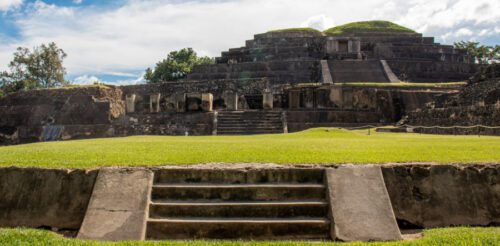
The San Andres El Salvador Mayan archaeological site is located in the valley of Zapotitan in the department of La Libertad. This Archaeological park is one of the largest Pre-Columbian sites in El Salvador. Excavations in San Andres have unveiled that this was an area for political and ceremonial events of great importance in the region.
According to historians, during the Late Classic Period, the Maya culture was at its highest point ever. At this point, San Andres was established as a principal regional city that controlled the surrounding areas.
Visiting the San Andres El Salvador Archaeological site.
There is no doubt that San Andres is one of the best Mayan ruins in El Salvador; it is definitely worth visiting, and it has many historic structures and a small museum.
The site is easy to get to, it is right off the Panamerican Highway or CA-1; this is one of the main roads in the area and the country. Also, it is centrally located; the site is about 33 kilometers from San Salvador and about 30 kilometers from the city of Santa Ana.
Furthermore, San Andres is located about five kilometers from Joya de Ceren, another top archeological site in the country. So, in a day, you can visit both, San Andres and Joya de Ceren.
You can definitely venture into San Andres on your own as is centrally located and near the main highway. Nevertheless, you should consider visiting this site with a Salvadoran tour company; they offer tour packages that will take you to other astonishing ruins nearby, in addition to San Andres.
Archaeological structures of San Andres Archaeological park.
The monumental center of San Andres is an area of about 20 hectares; here, you will find a complex of pyramids and appended buildings.
The San Andres site is divided into two sections, the Acropolis which has four structures, and the Great Plaza, located on the north side of the Acropolis.
The Acropolis is an elevated plaza with pyramids and residence houses on top. An Acropolis area was common in Mayan political centers; this was an exclusive area for the site’s rulers and acted as a visual symbol of its high social position.
On the north and west ends of the Acropolis is a series of rooms or chambers. These rooms are described as the residential area of the ruling elite in San Andres.
The north part of this site has a large plaza; here, you will find other pyramids that include a bell-shaped one. Additionally, in the surrounding area, you will find small huts; this is where farmers who harvested the main products lived.
Indigenous people built the San Andres structures with adobe blocks; however, two structures were built with blocks of volcanic rock, also known locally as Talpetate.
History.
San Andres is a Pre-Columbian or Pre-Hispanic Mayan site in the valley of Zapotitan. The area’s occupation started around 900BC as an agricultural area.
The early settlement left around AD250 due to the massive eruption of the Lake Ilopango volcanic caldera. Then, the area was reoccupied during the 5th century.
The main occupation of San Andres was during the Late Classic Period, between AD650 and AD900; this period was the height of the Mayan civilization. During this time, San Andrés was the capital of a Mayan lordship, which controlled the smallest settlements in the valley of Zapotitan.

Other information.
As of Today 2020, the entrance fee to the park is $1.00 for Salvadoran adults and $3.00 for foreigners. Of course, children under age 12 and adults over 60 enter for free.
San Andres is located at kilometer 35 on the PanAmerican highway, in the department of La Libertad; undoubtedly, it is not difficult getting to this archaeological site.
The San Andres settlement is located on the banks of the Sucio river or Rio Sucio in Spanish; it is towards the central part of the Zapotitan Valley. This region is well-known for its fertility, an essential factor for the farming communities that developed in pre-Hispanic times.
San Andres El Salvador.
Visiting the San Andres Mayan ruins in El Salvador is a fantastic way to spend a day exploring and learning about the Salvadoran Indigenous culture.
As I previously stated in other articles, the Mayan ruins in El Salvador as not as impressive as the ones in Guatemala or Honduras. Nonetheless, sites like San Andres offer plenty for visitors to explore and enjoy.
If you want to visit other archaeological sites in El Salvador. Certainly, I recommend you venture into one of the following, Casa Blanca, Tazumal, or Cihuatan; obviously, these are some of the best Mayan ruins in El Salvador.





